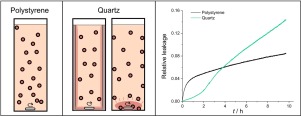Chemistry and Physics of Lipids ( IF 3.4 ) Pub Date : 2018-08-01 , DOI: 10.1016/j.chemphyslip.2018.07.006 Emma K. Eriksson , Víctor Agmo Hernández

|
Liposome solute permeability experiments are widely performed to gain information about lipid membrane characteristics. Spectroscopic methods are often used for this purpose, usually monitoring the leakage of a self-quenching fluorescent dye (e.g., carboxyfluorescein, CF) from the liposomes. Hereby, we investigate the effect of liposome-cuvette interactions, a seldom considered detail, on the results obtained from liposomal permeability experiments. The spontaneous leakage of CF from liposomes with different surface properties and phase states is followed using quartz and polystyrene cuvettes, and the results are compared. It is shown that for most lipid compositions the leakage profiles vary notably between different cuvette materials. Reproducibility of the measurements also varies depending on the cuvettes used, with polystyrene providing with more robust results. To explain these observations, the interaction of liposomes with polystyrene and quartz-like surfaces was characterized with the help of the quartz crystal microbalance with dissipation monitoring (QCM-D). Our results show that, while liposomes seldom interact with polystyrene, quartz-liposome interactions are almost unavoidable and have a large impact on the leakage experiments mainly via two mechanisms: i) the rupturing of liposomes on the cuvette surface causing a fast release of encapsulated CF, and ii) the disruption of adsorbed liposomes caused by magnetic stirring. Depending on their composition, the liposomes interact in different ways with quartz, affecting thus the extent of each proposed mechanism. The experiments demonstrate the importance of considering the cuvette material when planning and conducting spectroscopic experiments with liposomes.
中文翻译:

比色皿材料的选择会影响脂质体的光谱泄漏和渗透性实验
脂质体溶质渗透性实验被广泛进行,以获取有关脂质膜特性的信息。光谱方法通常用于此目的,通常监测脂质体中自猝灭荧光染料(例如羧基荧光素,CF)的泄漏。因此,我们研究了脂质体-比色皿相互作用(很少考虑的细节)对脂质体通透性实验结果的影响。使用石英和聚苯乙烯比色杯跟踪CF从具有不同表面性质和相态的脂质体中自发泄漏,并比较结果。已经表明,对于大多数脂质组合物,在不同的比色皿材料之间,泄漏曲线显着变化。测量的可重复性还取决于所使用的比色杯,聚苯乙烯具有更强大的结果。为了解释这些观察结果,借助具有耗散监测(QCM-D)的石英晶体微量天平,对脂质体与聚苯乙烯和类石英表面的相互作用进行了表征。我们的结果表明,尽管脂质体很少与聚苯乙烯相互作用,但石英-脂质体的相互作用几乎是不可避免的,并且主要通过以下两种机制对泄漏实验产生重大影响:i)试管表面上的脂质体破裂,导致封装的CF快速释放ii)磁力搅拌引起的脂质体吸附破坏。根据它们的组成,脂质体以不同的方式与石英相互作用,从而影响每种提出的机制的程度。











































 京公网安备 11010802027423号
京公网安备 11010802027423号